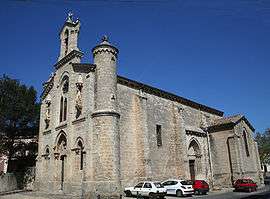Le Pouget
| Le Pouget | ||
|---|---|---|
|
The church of Sainte-Catherine | ||
| ||
 Le Pouget | ||
|
Location within Occitanie region  Le Pouget | ||
| Coordinates: 43°35′36″N 3°31′32″E / 43.5933°N 3.5256°ECoordinates: 43°35′36″N 3°31′32″E / 43.5933°N 3.5256°E | ||
| Country | France | |
| Region | Occitanie | |
| Department | Hérault | |
| Arrondissement | Lodève | |
| Canton | Gignac | |
| Intercommunality | Vallée de l'Hérault | |
| Government | ||
| • Mayor (2008–2014) | Louis Villaret | |
| Area1 | 13.91 km2 (5.37 sq mi) | |
| Population (2008)2 | 1,794 | |
| • Density | 130/km2 (330/sq mi) | |
| Time zone | CET (UTC+1) | |
| • Summer (DST) | CEST (UTC+2) | |
| INSEE/Postal code | 34210 / 34230 | |
| Elevation |
25–161 m (82–528 ft) (avg. 95 m or 312 ft) | |
|
1 French Land Register data, which excludes lakes, ponds, glaciers > 1 km² (0.386 sq mi or 247 acres) and river estuaries. 2 Population without double counting: residents of multiple communes (e.g., students and military personnel) only counted once. | ||
For the hydroelectric power station on the River Tarn, see Le Pouget (power station).
Le Pouget is a commune in the Hérault department in the Occitanie region in southern France. It contains the Gallardet dolmen.
Geography
Le Pouget is situated on the sides of two valleys, Aumelas and Clermont L'Hérault. The centre of the commune is at the entrance to the medieval circulade. The clay soil favours viticulture. The Hérault river is 2 km from the centre.
History
The village was known for its circulade in the Middle Ages in the time of Louis XIV. The prehistoric dolmen Gallardet (or dolmen de Pouget) is a notable sight in the village.
Population
| Historical population | ||
|---|---|---|
| Year | Pop. | ±% |
| 1962 | 1,035 | — |
| 1968 | 1,077 | +4.1% |
| 1975 | 934 | −13.3% |
| 1982 | 987 | +5.7% |
| 1990 | 1,103 | +11.8% |
| 1999 | 1,347 | +22.1% |
| 2008 | 1,794 | +33.2% |
Inhabitants are Pougétois.
Sights
- Église Saint-Jacques, Romanesque church (now the Chapelle des pénitents blancs)
- Église Sainte-Catherine, Gothic church (now the parish church)
- Dolmen
- Saint-Amant fountain
- The circulade
- Château de l'Estang (private property).
- Entrance to dolmen
Personalities
- d'Alzon family
- Jacqueline Mirande, French novelist
- Jean-Paul Nozière, French novelist
See also
References
External links
| Wikimedia Commons has media related to Le Pouget. |
This article is issued from Wikipedia - version of the 11/12/2016. The text is available under the Creative Commons Attribution/Share Alike but additional terms may apply for the media files.

.svg.png)